Not registered?
If you have not yet registered on the Valsir web site fill in the form with your details and obtain free access to the download area where you will be free to download our price lists and technical brochures. You will also have the possibility of receiving our periodic newsletter: the best way to remain up-to-date on all the latest developments in Valsir.
Valsir performed a LCA on the polyethylene and polypropylene pipe.
Life Cycle Assessment is a technique to assess the “environmental impact” of the product, “from the cradle to the grave”.
It is performed by quantifying the impact resulting from the use of resources (energy, raw materials, water) and from environmental releases (to the air, water and land), the consequences for human health, the quality of the ecosystem and the depletion of resources.
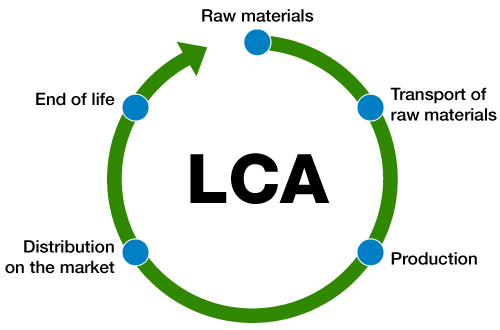
All the processes that contribute to obtaining the product are analysed and assessed, as if they were examined under a magnifying glass, from the production and transport of the raw materials, to the manufacturing process itself, from distribution on the market and use, to its disposal or recycling.
It was decided to carry out the first LCA on the systems of pipes and fittings in polyethylene and polypropylene in that they represent a historical and fundamental part of Valsir production.
They also represent the technological basis on which other fundamental products were developed within the Valsir range, such as the PP3, Silere® and Triplus® waste and drainage systems.
This primary analysis allows us to create a base for performing life cycle assessments on the remaining waste and drainage product lines.
The objective of this study is the quantification of the environmental impact of the polypropylene pipe along its life cycle. The functional unit is 1 metre of pipe of diameter 110 mm.
A service life of 50 years was considered.
All the stages of the product’s life cycle were studied with the exception of use: raw material extraction and transport, materials processing, packaging, worldwide distribution and the end-of-life phase.
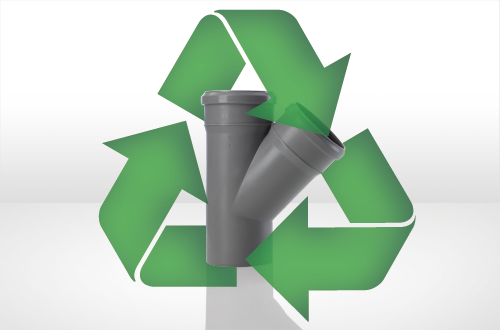
For the processes that are performed within the Valsir factory in Vobarno (BS) primary data were collected, whereas for the other processes secondary data were used from the ecoinvent database. The data refer to the first eight months of 2014. To facilitate the LCA calculations the LCA software SimaPro 8 was used.
For the assessment of the environmental impact two methods of analysis were used: EPD and Recipe. The results are indicated in the table (EPD) and graph (Recipe) below.
The EPD method is composed of six environmental indicators deduced using the CML method 2013: global warming, thinning of the ozone layer, photochemical oxidant creation, acidification, eutrophication and the use of abiotic resources. The impact category concerning global warming was updated according to IPCC 2013.
Tab. 1: Results of the characterisation, EPF method.
| Global warming |
Thinning of ozone layer |
Acidification | Eutrophication | Photochemical oxidant creation |
Abiotic resource depletion |
|
| Unit | kg CO2 eq | mg CFC-11 eq | g SO2 eq | g P43- eq | g C2H4 eq | mg Sb eq |
| Total | 2,87 | 0,07 | 9,86 | 6,29 | 0,61 | 3,77 |
| Raw material | 2,07 | 0,02 | 7,24 | 3,69 | 0,44 | 2,84 |
| Production | 0,33 | 0,04 | 1,31 | 0,30 | 0,10 | 0,27 |
| Distribution | 0,18 | 0,01 | 0,84 | 0,17 | 0,02 | 0,45 |
| End-of-life | 0,22 | 0,00 | 0,08 | 1,99 | 0,01 | 0,01 |
| Pack LCA | 0,07 | 0,00 | 0,39 | 0,15 | 0,04 | 0,20 |
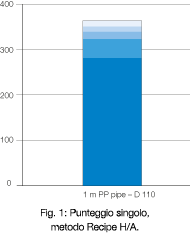
The ReCiPe method is a tool for calculating the totality of the impacts, considering 17 different categories that can be grouped together in three macro-categories: Human Health, Ecosystems and Resources.
The method also includes the possibility of summarizing all the categories in one single value, measured in eco-points; the calculation was performed according to the ReCiPe endpoint method (H) V1.05/Europe ReCiPe H/A.
The calculation performed with the EPD and with the ReCiPe method indicated that the raw materials stage is responsible for the majority of the contributions
For more information on the LCA of PP please contact This email address is being protected from spambots. You need JavaScript enabled to view it. .
The objective of this study is the quantification of the environmental impact of the polyethylene pipe along its life cycle. The functional unit chosen to represent the entire HDPE range is 1 metre of pipe of diameter 110 mm of the HDPE pipe product line. A service life of 50 years was considered.
All the stages of the product’s life cycle were studied with the exception of the use stage: raw material extraction and transport, materials processing, packaging, worldwide distribution and the end-of-life phase.
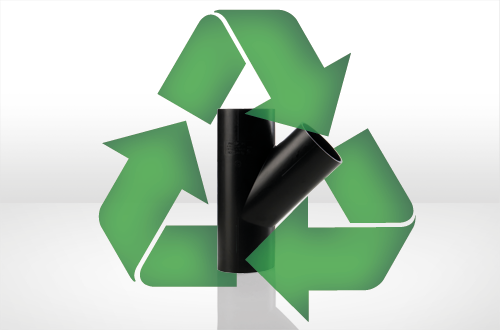
For the processes that are performed within the Valsir factory in Vobarno (BS) primary data were collected, whereas for the other processes secondary data were used from the ecoinvent database. The data refer to the first eight months of 2014. To facilitate the LCS calculations the LCA software SimaPro 8 was used.
For the assessment of the environmental impact, two methods of analysis were used: EPD and ReCiPe. The results are indicated in the table (EPD) and graph (ReCiPe) below.
The EPD method is composed of six environmental indicators deduced using the CML method 2013: global warming, thinning of the ozone layer, photochemical oxidant creation, acidification, eutrophication and the use of abiotic resources. The impact category concerning global warming was updated according to IPCC 2013.
Tab. 1: Results of the characterization, EPD method.
| Global warming |
Thinning of ozone layer |
Acidification | Eutrophication | Photochemical oxidant creation |
Abiotic resource depletion |
|
| Unit | kg CO2 eq | mg CFC-11 eq | g SO2 eq | g P43- eq | g C2H4 eq | mg Sb eq |
| Total | 4,1 | 0,12 | 14,13 | 5,24 | 1,13 | 1,67 |
| Raw material | 3,02 | 0,04 | 10,03 | 0,96 | 0,9 | 0,88 |
| Production | 0,48 | 0,06 | 1,51 | 0,31 | 0,13 | 0,28 |
| Distribution | 0,23 | 0,02 | 2,28 | 0,30 | 0,07 | 0,42 |
| End-of-life | 0,34 | 0,00 | 0,13 | 3,61 | 0,02 | 0,01 |
| Pack LCA | 0,03 | 0,00 | 0,18 | 0,06 | 0,02 | 0,08 |
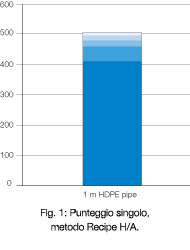
The ReCiPe method is a tool for calculating the totality of the impacts, considering 17 different categories that can be grouped together in three macro-categories: Human Health, Ecosystems and Resources.
The method also includes the possibility of summarizing all the categories in one single value, measured in eco-points; the calculation was performed according to the ReCiPe endpoint method (H) V1.05/Europe ReCiPe H/A.
The calculations performed with the EPD and with the ReCiPe method indicated that the raw materials stage is responsible for the majority of the contributions.
For more information on the LCA of HDPE please contact This email address is being protected from spambots. You need JavaScript enabled to view it. .